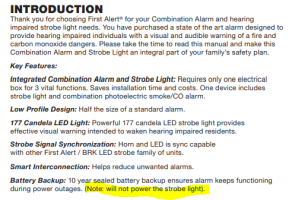Yikes
SAWHORSE
I say "yes", and it won't be the first time that a manufacturer has (IMO erroneously) claimed ADA compliance.
Example:

But wait - - open the Owner's manual, and it says the strobe won't operate during power failure:

ADA 809.5.2.1 requires visible alarms in communication units. During a power outage the audio alarm will operate but the visible strobe won't. And a power outage is when residents are more likely to use candles or other open flames in their units.
So, under ADA 233.3.5, how is this an equivalent facilitation for persons with hearing impairments?
BTW, I'm not picking on First Alert. Kidde and other manufacturers have the same issues.
At the moment, I'm not sure I can have an ADA compliant communications unit using all-in-one combo units without also adding an external battery backup + inverter.
Example:
First Alert Hardwired Smoke and CO Alarm with LED Strobe Light and 10-Year Sealed Battery - 7030BSL (1038870)

But wait - - open the Owner's manual, and it says the strobe won't operate during power failure:

ADA 809.5.2.1 requires visible alarms in communication units. During a power outage the audio alarm will operate but the visible strobe won't. And a power outage is when residents are more likely to use candles or other open flames in their units.
So, under ADA 233.3.5, how is this an equivalent facilitation for persons with hearing impairments?
BTW, I'm not picking on First Alert. Kidde and other manufacturers have the same issues.
At the moment, I'm not sure I can have an ADA compliant communications unit using all-in-one combo units without also adding an external battery backup + inverter.




